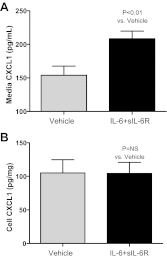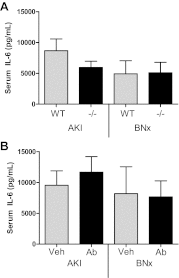Circulating IL-6 mediates lung injury via CXCL1 production after acute kidney injury in mice
- PMID: 22791336
- PMCID: PMC3468527
- DOI: 10.1152/ajprenal.00025.2012
Circulating IL-6 mediates lung injury via CXCL1 production after acute kidney injury in mice
Abstract
Serum IL-6 is increased in patients with acute kidney injury (AKI) and is associated with prolonged mechanical ventilation and increased mortality. Inhibition of IL-6 in mice with AKI reduces lung injury associated with a reduction in the chemokine CXCL1 and lung neutrophils. Whether circulating IL-6 or locally produced lung IL-6 mediates lung injury after AKI is unknown. We hypothesized that circulating IL-6 mediates lung injury after AKI by increasing lung endothelial CXCL1 production and subsequent neutrophil infiltration. To test the role of circulating IL-6 in AKI-mediated lung injury, recombinant murine IL-6 was administered to IL-6-deficient mice. To test the role of CXCL1 in AKI-mediated lung injury, CXCL1 was inhibited by use of CXCR2-deficient mice and anti-CXCL1 antibodies in mice with ischemic AKI or bilateral nephrectomy. Injection of recombinant IL-6 to IL-6-deficient mice with AKI increased lung CXCL1 and lung neutrophils. Lung endothelial CXCL1 was increased after AKI. CXCR2-deficient and CXCL1 antibody-treated mice with ischemic AKI or bilateral nephrectomy had reduced lung neutrophil content. In summary, we demonstrate for the first time that circulating IL-6 is a mediator of lung inflammation and injury after AKI. Since serum IL-6 is increased in patients with either AKI or acute lung injury and predicts prolonged mechanical ventilation and increased mortality in both conditions, our data suggest that serum IL-6 is not simply a biomarker of poor outcomes but a pathogenic mediator of lung injury.
Figures








References
-
- Chertow GM, Christiansen CL, Cleary PD, Munro C, Lazarus JM. Prognostic stratification in critically ill patients with acute renal failure requiring dialysis. Arch Intern Med 155: 1505–1511, 1995 - PubMed
Publication types
MeSH terms
Substances
Grants and funding
LinkOut - more resources
Full Text Sources
Molecular Biology Databases

